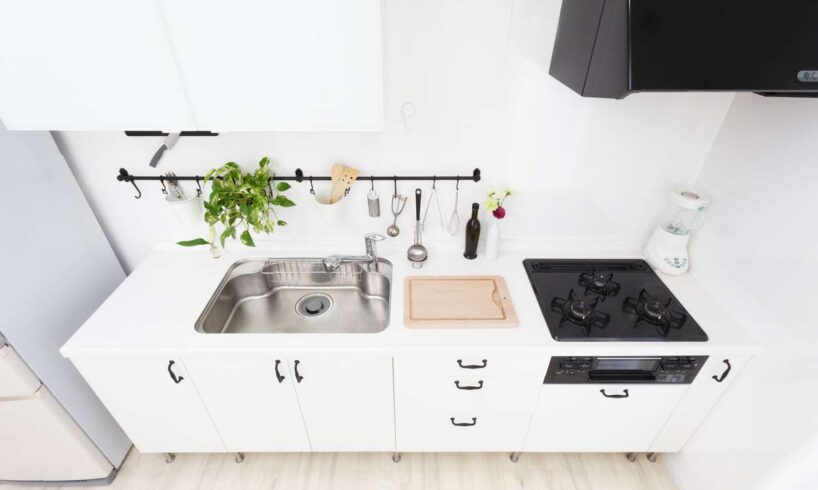
Roughly 94% of Japanese households do not have a built-in oven. And if you’re used to baking lasagna, roasting a whole turkey, or even just reheating pizza on a baking sheet, this can be kind of a shock when you first move here.
Japanese Kitchens Are Compact for a Reason
If you’ve ever stepped into a typical Japanese apartment, you’ve probably noticed one thing right away: the kitchen is tiny. We’re talking a sink, a single stove ring, maybe a fridge that’s half the size of a Western one — and barely any counter space.
Tokyo local Hiro put it bluntly:
“I don’t really have that many recipes that need an oven! A lot of Japanese food is not baked, and I can use my microwave and toaster. Honestly, my kitchen is so small that I eat out a lot. With the price of rice going up, especially, it’s often cheaper for me to do that. If I could afford a big place and had time to cook, maybe I’d have one.”
Japanese homes, especially in urban centers, are designed to be ultra-efficient. Traditional meals like nabe (hot pot), yakitori (grilled skewers), and nimono (simmered dishes) are cooked on the stovetop or grill/broiler, not in the oven. Baking just never became a home kitchen necessity in Japan.
The Rise of the Microwave-Oven Hybrid
One of the most popular appliances in Japan is the denshi renji (microwave oven) — and many of them are combo units that microwave and function as small convection ovens. But they’re not exactly intuitive.
Gemima, a designer who moved to Tokyo from Australia, told us:
“I really missed my oven at first since I liked baking cakes a lot. I have a microwave oven now that melts anything that touches the roof when I put it into oven mode, so it’s kind of a pain to use.”
These hybrid units can roast, bake, toast and microwave. But they’re not going to fit your big casserole dish or the Thanksgiving turkey. If you’ve ever tried to bake cookies in one, you know it’s a game of rotating trays and praying your dough doesn’t crisp unevenly.
The Fish Grill: Japan’s Hidden Kitchen Essential
If you’ve ever peeked under the gas stove in a Japanese kitchen, you might have noticed a narrow pull-out drawer. Many foreigners mistake it for storage at first, but it’s actually a grill or broiler.
While it’s much more compact than an oven, it often uses the same space beneath the countertop. In the West, if something isn’t cooked on the hob, it usually goes in the oven. In Japan, it’s hob or grill.
These compact broilers are perfect for grilling fish, toasting bread, roasting vegetables or crisping up yakitori skewers. Because they can char food directly, they’re ideal for blistering peppers for salsa, charring aromatics, or making dips like baba ghanoush. You can even use it to get that perfectly burnt top on gratin or mac and cheese casserole. You can also add water to the tray below to steam-grill shellfish, or wrap hamburg steak in foil and slow-cook it. And of course, this is where people in Japan toast their mochi.
Unlike Western ovens, they’re small, fast-heating and designed for daily use. Combined with the microwave oven, these grills make traditional ovens less essential in Japanese kitchens.
Airfryers, Toaster Ovens, and the DIY Oven Life
When we asked around about alternatives, the air fryer came up a lot. Miko, who lived in the U.S. for 10 years before returning to Tokyo, swears by hers:
“I have an air fryer that I religiously use. I can cook anything, and it takes up less space and heating time than an oven, so it works for me! It’s very uncommon for Tokyo kitchens to have space in the kitchen for a traditional oven like I used to have in the U.S.”
Toaster ovens are another big hit here. They’re small, affordable, and surprisingly powerful. You can toast bread, reheat leftovers, roast vegetables and even bake cakes — if you’re willing to go a little mini.
Read this guide to airfryers in Japan for recipe ideas.
Eating Out is the Backup Plan (and Sometimes the First Plan)
Convenience stores and supermarkets in Japan are absurdly good. From karaage (fried chicken) to fresh sushi and seasonal bento (lunch boxes), there’s very little incentive to cook everything from scratch — especially when you’re short on time or space.
And with places like Ootoya, Matsuya, or even the local depachika (department store basement food halls), hot meals are accessible for under ¥1,000.
Many locals, like Hiro, genuinely find it cheaper and easier to grab meals outside rather than stock an expensive pantry — especially now, with prices of staples like rice going up.
So, Why Japanese Homes Don’t Have Ovens And Do You Need an Oven in Japan?
Short answer: No.
Longer answer: It depends on your cooking style. If you’re big into baking, you’ll need to either invest in a countertop oven or get creative with what’s available. But plenty of people—both locals and expats—live without one just fine.
The key is adapting. You might not be able to make a Thanksgiving turkey in your 1K apartment, but you can learn to love the stovetop, embrace the world of airfrying, and maybe even find your new go-to dish in the freezer section of 7-Eleven.
If you’re thinking of grilling this summer, try reading our article: The Ultimate Japanese BBQ Guide: Grilling Tips, Recipes and Must-Try Foods.
And if you’re celebrating Thanksgiving, check out these restaurants in Tokyo that offer Thanksgiving dinners.





